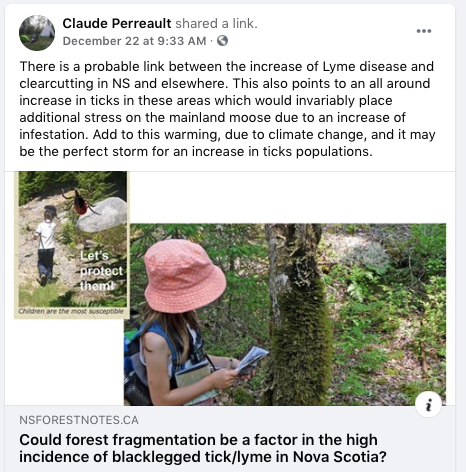From Annapolis Royal & Area – Environment & Ecology Dec 22, 2020
BW to CP:
– I suspect there is a very strong connection between clear-cutting and ticks. I’ve spent quite a bit of time in mature forest and only rarely came home with ticks on me. However, walking through brushy places – clear-cut slash, sides of open trails, brush along waterways, and I almost always end up with them on me. If we consider that deer are quite attracted to openings in forest where they find the browse they are looking for, it stands to reason that there will be an elevated risk of picking up ticks. The ticks that do the most damage to Moose, Elk, etc.. are the Winter Tick. While they do feed on Deer, the Deer have different grooming behaviour and can remove a lot of the ticks. Moose and several other species of ungulates do not groom as fastidiously, so the ticks get attached and feed until they are very large and taking a major toll on the health of the host animal. I’ll link to a webpage from Quebec that explains that. Anyhow, any land management approach that encouraged Deer to move into Moose territory will be detrimental to the health of Moose as it will bring both Winter Ticks and the Brainworm which does not do as much damage to Deer, but is usually fatal to Moose. In addition, as you have mentioned, Climate Change is partly the problem, but so is habitat as, in winter, Moose by preference, will spend more time in mature forest where ticks would drop to the snow in early spring – and some would die or be eaten by birds such as Chickadees and Bluejays. However, Winter Ticks that fall into clear-cut areas will likely be falling to bare ground as the snow will have melted away, and they can survive to lay eggs and multiply. I think it is important that we pay attention to full life cycles and to how they relate to habitat and health of wildlife. Unfortunately, it seems that that isn’t being discussed as much as it should be. Instead, all we hear is that Moose are dying as a result of Climate Change and contact with Deer, without much discussion of why Deer and Moose habitat is overlapping as much as it is now — due to land management changes.
https://mffp.gouv.qc.ca/english/wildlife/wildlife-habitats/winter-tick.jsp
CKT: Agreed. I have often thought that various forestry practices have led to an increase tick population.
I am not a very scientific person but clear cuts removes the homes and foods of the natural predators of ticks. You remove the predators of any species you get an explosion of that species. https://buglord.com/what-animals-eat-ticks/
CP: So seems to me the province has a dual ethical responsibility here. The consequences to human health and to an endangered species should be accounted for. The financial toll with regards to excessive clear-cuts are a possible increase in healthcare due to an increase in cases of Lyme disease and an environmental eyesore that impacts eco-tourism. Yet, there are also other impacts to be considered also. There’s a tipping point where the financial benefit of allowing the scale of clearcutting we are seeing is negated by the financial loss in other sectors. If we are simply talking dollars here which is not the end of the story!

